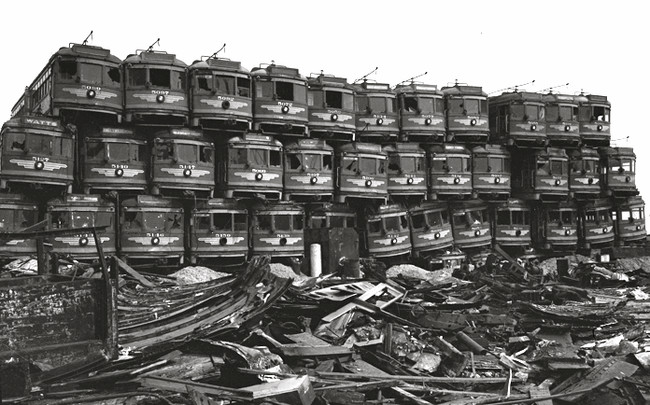MindMover
MindMover's JournalChris Hayes...The Con plays his base for bitter fools lost in feeling sorry for themselves
https://twitter.com/chrislhayes/status/1225471908143083521WTF ...201
There was a rumor that between 1938 and 1950, officials at General Motors were buying up train and light rail systems in cities so that people would have to buy more cars. The only falsity in this theory turned out to be that it wasn't just GM that was in on this ploy, but several other companies, as well.
Its no wonder we don't have public transportation like every other developed country ...
http://en.wikipedia.org/wiki/General_Motors_streetcar_conspiracy
The Great Weed Rebrand: Inside Colorado’s Cannabis Lifestyle Industry
The first thing I notice about doing yoga stoned is my pulse. That otherwise inconspicuous sign of life is suddenly very much present, from my forehead to my pelvis, and the latter makes me want to giggle. I think it's okay to giggle, and so I do. Here inside this garage-turned-yoga studio in central Denver, everyone around me is making noises—giggles and more—upon taking her turn hitting the communal vape that's being passed around.
After another healthy inhale of vaporized weed, we flow through our vinyasa, and I start to take note of everything in the room: the intricate weave of the fishtail braid of the girl sitting behind me, the beads of sweat dripping down my spine, the goofy facial expression the woman to my right is making, likely the result of the drug’s effect tickling her eyelids and mouth corners. Eventually, my thoughts turn from fleeting to fixated, and by the time we hit happy baby pose, my back is melting into the mat and I’m taking in heavy, delicious breaths.
Shannon Donnelly, a 26-year-old pot entrepreneur and the class’s organizer, later tells me the reason I’m able to breathe so deeply is because of the relaxing indica strain we’re smoking. Its name is Flo and it’s a bronchial dilator, believed to help expand the lungs to facilitate intense breathing. Pair this strain with vaping, the preferred method of indulging for the health conscious, and you’ve got the ideal yoga practice.
“There’s this common misconception that smoking cannabis makes you slow and lazy, but it’s not true—there are some strains that are actually great for exercising,” Donnelly tells the group of a dozen women who are attending her marijuana yoga class one Sunday afternoon in March. “Vaping is much better than smoking. There’s no carbon dioxide, tar, heat, or carcinogens getting into your lungs. Vaping is a great alternative for asthmatics too, because it’s not harsh.”
http://www.racked.com/2015/4/20/8416799/marijuana-colorado-cannabis-wellness-lifestyle
Happy 420 everyone !!!!!!!!!!!!!!!!
OMG ...........

I know its an old story but with all that is going on in this world of ours, I certainly thought we could use some good old news ...
http://abcnews.go.com/blogs/headlines/2012/08/bill-clinton-inspires-uganda-bill-clinton/
The Scene of the Crime (Return to My Lai)
There is a long ditch in the village of My Lai. On the morning of March 16, 1968, it was crowded with the bodies of the dead—dozens of women, children, and old people, all gunned down by young American soldiers. Now, forty-seven years later, the ditch at My Lai seems wider than I remember from the news photographs of the slaughter: erosion and time doing their work. During the Vietnam War, there was a rice paddy nearby, but it has been paved over to make My Lai more accessible to the thousands of tourists who come each year to wander past the modest markers describing the terrible event. The My Lai massacre was a pivotal moment in that misbegotten war: an American contingent of about a hundred soldiers, known as Charlie Company, having received poor intelligence, and thinking that they would encounter Vietcong troops or sympathizers, discovered only a peaceful village at breakfast. Nevertheless, the soldiers of Charlie Company raped women, burned houses, and turned their M-16s on the unarmed civilians of My Lai. Among the leaders of the assault was Lieutenant William L. Calley, a junior-college dropout from Miami.
By early 1969, most of the members of Charlie Company had completed their tours and returned home. I was then a thirty-two-year-old freelance reporter in Washington, D.C. Determined to understand how young men—boys, really—could have done this, I spent weeks pursuing them. In many cases, they talked openly and, for the most part, honestly with me, describing what they did at My Lai and how they planned to live with the memory of it.
In testimony before an Army inquiry, some of the soldiers acknowledged being at the ditch but claimed that they had disobeyed Calley, who was ordering them to kill. They said that one of the main shooters, along with Calley himself, had been Private First Class Paul Meadlo. The truth remains elusive, but one G.I. described to me a moment that most of his fellow-soldiers, I later learned, remembered vividly. At Calley’s order, Meadlo and others had fired round after round into the ditch and tossed in a few grenades.
Then came a high-pitched whining, which grew louder as a two- or three-year-old boy, covered with mud and blood, crawled his way among the bodies and scrambled toward the rice paddy. His mother had likely protected him with her body. Calley saw what was happening and, according to the witnesses, ran after the child, dragged him back to the ditch, threw him in, and shot him.
http://www.newyorker.com/magazine/2015/03/30/the-scene-of-the-crime
The Growing Degradation of Work and Life, and What We Might Do to End It
n a recent New York Times' article, former labor editor Steven Greenhouse writes about how employers in the service sector often demand that their employees work shifts that allow them little time for rest. For example, a worker might have to close a night shift on Wednesday and open the morning shift on Thursday:
"At Hudson County Community College in Jersey City, Ramsey Montanez struggles to stay alert on the mornings that he returns to his security guard station at 7 am, after wrapping up a 16-hour double shift at 11 pm the night before."
Given that it takes precious minutes to get home, at least an hour or two to wind down and take care of chores, and an hour or more to prepare and then get back to work the next morning, Montanez probably has to get by on no more than five hours of sleep. If he has children or is responsible for the care of others, then the time crunch is still worse.
The practice of having employees close late and open early has become common enough that there is now a word for it - "clopening." Management justifies the practice by claiming that turnover in restaurant and other service jobs is so high that only the relatively few longer-term employees are sufficiently trustworthy and "have the authority and experience to close at night and open in the morning." Labor advocates say that the reason for clopening is that scheduling is often no longer done by actual managers but by "sophisticated software" purchased by companies.
http://www.truth-out.org/news/item/29643-the-growing-degradation-of-work-and-life-and-what-we-might-do-to-end-it
========================================================
Sad that the only economic game in town is degrading all life on this planet ...
'Megadrought' threatens U.S. Southwest, Plains in decades to come, says study
The U.S. Southwest and Central Plains regions are likely to be scorched by a decades-long "megadrought" in the second half of this century if climate change continues unabated, scientists from NASA and Cornell and Columbia universities have warned.
In a study published by the journal Science Advances this week, the researchers forecast that future drought risk in the area is likely to exceed even the driest conditions experienced during extensive Medieval-era periods that have been dubbed "megadroughts."
UN climate talks at crossroads on how to fight global warming
UN climate change report offers stark warnings, hope
Climate change survey reveals Canadians' fears for future generations
Arctic meltdown: A changing world
There is an 80 per cent chance of an extended drought between 2050 and 2099 unless aggressive steps are taken to mitigate the impacts of climate change, the article predicted.
"Ultimately, the consistency of our results suggests an exceptionally high risk of a multidecadal megadrought ... (and) a level of aridity exceeding even the persistent megadroughts that characterized the Medieval era," the scientists wrote.
http://www.cbc.ca/news/technology/megadrought-threatens-u-s-southwest-plains-in-decades-to-come-says-study-1.2957793
Why the 1% should pay tax at 80%
In the United States, the share of total pre-tax income accruing to the top 1% has more than doubled, from less than 10% in the 1970s to over 20% today (pdf). A similar pattern is true of other English-speaking countries. Contrary to the widely-held view, however, globalisation and new technologies are not to blame. Other OECD countries, such as those in continental Europe, or Japan have seen far less concentration of income among the mega rich.
At the same time, top income tax rates on upper income earners have declined significantly since the 1970s in many OECD countries – again, particularly in English-speaking ones. For example, top marginal income tax rates in the United States or the United Kingdom were above 70% in the 1970s, before the Reagan and Thatcher revolutions drastically cut them by 40 percentage points within a decade.
At a time when most OECD countries face large deficits and debt burdens, a crucial public policy question is whether governments should tax high earners more. The potential tax revenue at stake is now very large.
For example, doubling the average US individual income tax rate on the top 1% income earners from the current 22.5% level to 45% would increase tax revenue by 2.7% of GDP per year – as much as letting all of the Bush tax cuts expire (only a small fraction of them lapsed in January 2013). But of course, this simple calculation is static: such a large increase in taxes may well affect the economic behaviour of the rich and the income they report pre-tax, the broader economy and, ultimately, the tax revenue generated. In recent research, we analyse this issue both conceptually and empirically using international evidence on top incomes and top tax rates since the 1970s.
http://www.theguardian.com/commentisfree/2013/oct/24/1percent-pay-tax-rate-80percent?CMP=share_btn_tw
==========================================
I put this comment in good reads for a very good reason ...
Profile Information
Member since: Sun Jul 31, 2011, 05:36 PMNumber of posts: 5,016
